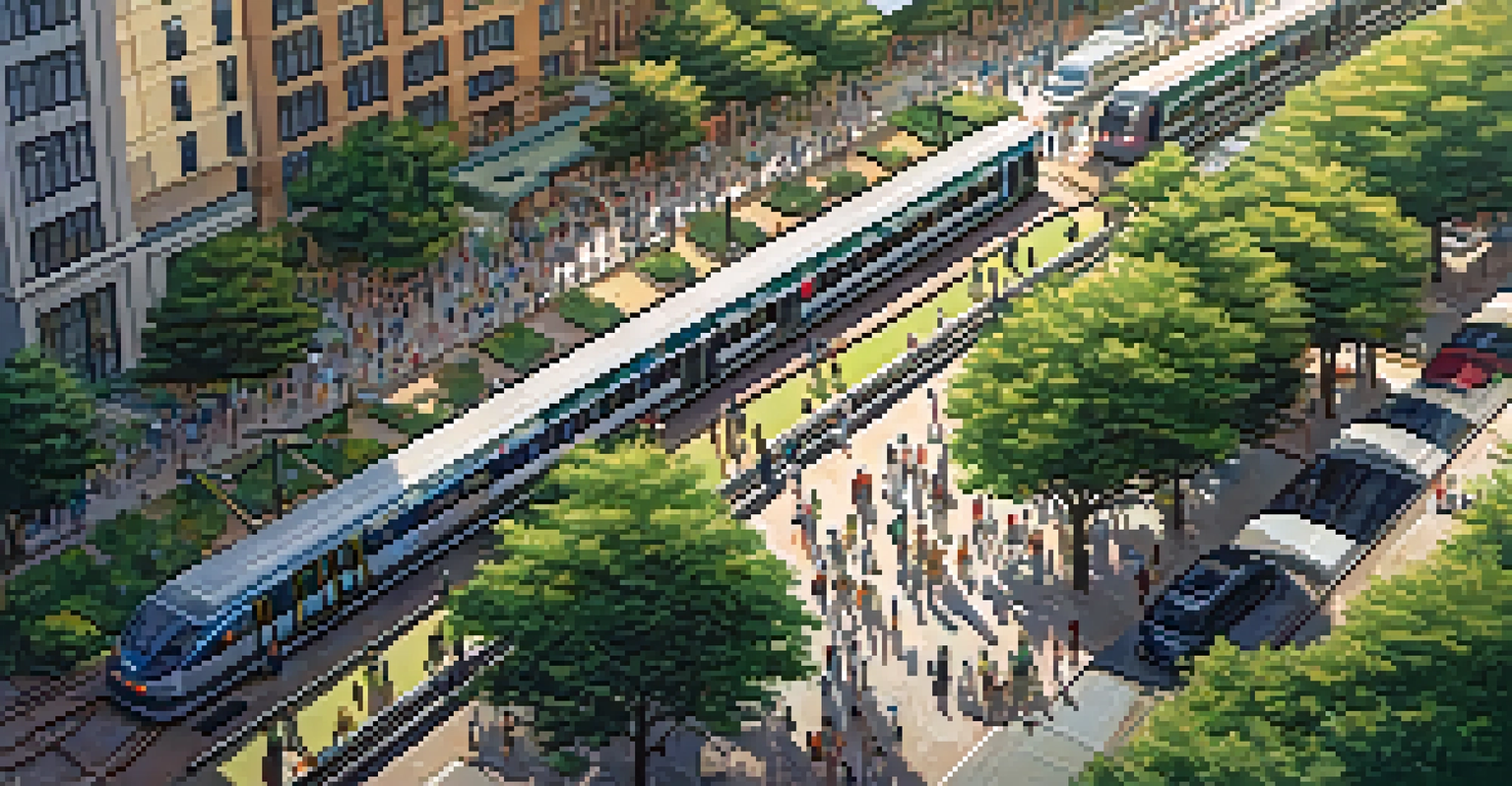Sustainable Urban Development Strategies for Houston's Future

Understanding Sustainable Urban Development in Houston
Sustainable urban development focuses on creating urban areas that meet the needs of the present without compromising future generations. In Houston, this means balancing growth with environmental preservation and social equity. As the city continues to expand, it's crucial to adopt strategies that promote sustainability, ensuring a livable environment for all residents.
Sustainability is no longer about doing less harm. It’s about doing more good.
This approach involves integrating green spaces, efficient public transportation, and renewable energy sources into urban planning. For Houston, a city known for its sprawling layout, the challenge is to rethink how we design our neighborhoods. By prioritizing sustainability, we can create a city that thrives economically while being mindful of its ecological footprint.
Ultimately, sustainable urban development is not just about buildings and infrastructure; it's about fostering community resilience. By involving local stakeholders in the planning process, we can develop solutions that truly reflect the needs and desires of Houston's diverse population.
Green Infrastructure: Enhancing Urban Resilience
Green infrastructure refers to a network of natural and semi-natural systems that provide environmental, economic, and social benefits. In Houston, implementing green roofs, parks, and urban forests can help manage stormwater, reduce heat, and improve air quality. This is particularly important in a city that faces the challenges of heavy rainfall and flooding.

By integrating green infrastructure into urban design, Houston can mitigate the impacts of climate change while enhancing the quality of life for its residents. For instance, creating more green spaces not only beautifies neighborhoods but also encourages outdoor activities and community gatherings. This fosters a sense of belonging and promotes mental well-being.
Sustainable Urban Development Focus
Houston must balance growth with environmental preservation and social equity to create a livable future.
Moreover, green infrastructure can be a cost-effective solution compared to traditional grey infrastructure. Investing in nature-based solutions often leads to lower long-term maintenance costs, making it a smart choice for Houston's budget-conscious planners.
Promoting Public Transportation for Reduced Emissions
Public transportation is a critical component of sustainable urban development. By investing in efficient transit systems, Houston can reduce its reliance on personal vehicles, leading to lower greenhouse gas emissions. This shift not only benefits the environment but also alleviates traffic congestion, making commutes more manageable for everyone.
The greatest threat to our planet is the belief that someone else will save it.
Expanding public transit options, such as buses and light rail, can connect neighborhoods that currently lack access to essential services. Imagine a city where residents can easily travel to work, school, and recreational activities without the stress of parking or traffic jams. This accessibility can enhance social equity and create a more inclusive urban environment.
Additionally, promoting public transit can encourage walking and biking, further contributing to a healthier lifestyle. As more residents choose to leave their cars behind, Houston can create a vibrant, pedestrian-friendly atmosphere that fosters community interaction and local business growth.
Incorporating Renewable Energy into Urban Planning
Renewable energy sources, such as solar and wind, play a vital role in achieving sustainable urban development. Houston, with its abundant sunshine, is well-positioned to harness solar energy to power homes and businesses. By integrating renewable energy into urban planning, the city can reduce its carbon footprint and promote energy independence.
Incorporating solar panels into new developments and retrofitting existing buildings can create a more sustainable energy landscape. Moreover, incentivizing residents and businesses to adopt renewable energy solutions can lead to cost savings and job creation in the green economy. This not only benefits the environment but also stimulates local economic growth.
Green Infrastructure Benefits
Implementing green infrastructure can enhance urban resilience by managing stormwater and improving air quality.
As Houston embraces renewable energy, it sets an example for other cities to follow. By showcasing the potential of clean energy solutions, Houston can lead the way in the transition towards a more sustainable future, inspiring other urban areas to take similar initiatives.
Community Engagement: The Heart of Sustainable Development
Community engagement is essential for successful sustainable urban development. Involving residents in decision-making processes ensures that their voices are heard and their needs are met. For Houston, this means creating platforms for dialogue and collaboration among diverse communities.
Workshops, public forums, and online surveys can facilitate meaningful conversations about urban planning and sustainability initiatives. By encouraging participation, Houston can foster a sense of ownership among residents, making them more likely to support and engage with sustainable practices in their neighborhoods.
Moreover, community engagement can lead to innovative solutions that are tailored to local contexts. When residents collaborate with planners and policymakers, they can identify unique challenges and opportunities, resulting in strategies that truly enhance the urban experience for everyone.
Affordable Housing: A Key Element of Sustainability
Sustainable urban development must also address the pressing issue of affordable housing. In Houston, rising property prices have made it increasingly difficult for low- and middle-income families to find suitable homes. By prioritizing affordable housing initiatives, the city can ensure that all residents have access to safe and stable living conditions.
Incorporating affordable housing into urban development plans promotes social equity and diversity. This means creating mixed-income neighborhoods where residents from various backgrounds can live and thrive together. Such communities are not only more resilient but also contribute to a richer cultural fabric in Houston.
Community Engagement is Essential
Involving residents in decision-making fosters ownership and leads to innovative, tailored solutions for urban challenges.
Additionally, sustainable housing solutions can reduce energy consumption and utility costs for families. By designing energy-efficient homes and utilizing renewable energy sources, Houston can create affordable housing options that are both economically and environmentally sustainable.
Smart Technology: Enhancing Urban Efficiency
Smart technology has the potential to revolutionize urban development by improving efficiency and sustainability. In Houston, implementing smart city solutions—such as smart traffic lights and energy management systems—can optimize resource use and reduce waste. This innovative approach allows the city to respond more effectively to the needs of its residents.
For example, smart traffic management can alleviate congestion and minimize travel times, making commuting more efficient. Additionally, smart grids can help monitor and optimize energy consumption in real-time, leading to significant cost savings for both the city and its residents. This integration of technology promotes a more responsive urban environment.

Moreover, smart technology can enhance public safety and community engagement. By utilizing data analytics and real-time information sharing, Houston can improve emergency response times and foster a stronger connection between local government and its residents.
Conclusion: A Vision for Houston's Sustainable Future
As Houston looks toward the future, embracing sustainable urban development strategies is crucial for creating a thriving city. By prioritizing green infrastructure, public transportation, and community engagement, Houston can become a model for sustainability in urban areas. The vision is clear: a city where economic growth aligns with environmental stewardship and social equity.
Each strategy discussed plays a vital role in shaping a more sustainable urban landscape. By integrating renewable energy, affordable housing, and smart technology into the fabric of city planning, Houston can tackle the challenges posed by rapid growth and climate change head-on.
Ultimately, the journey toward a sustainable Houston is a collaborative effort involving residents, businesses, and local government. Together, we can create a vibrant urban environment that meets the needs of today while safeguarding the future for generations to come.